





TECHNICAL INTERIM REPORT
LIFE 2003 NAT / RO / 000027 / REV
Restoration Forest habitats from Pietrosul rodnei biosphere reserve
Project Manager
Dr. Ioan Blada
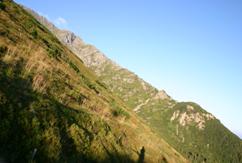
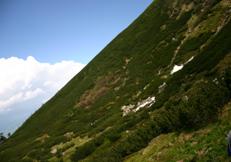
Period: January 1, 2004 - December 31, 2006
Bucharest 2006
Restoration Forest habitats from Pietrosul rodnei biosphere reserve
? Introduction
The 2004 was the first year of the project that initially was planned to start on 01 June 2003 and to be finished on 01 June 2007 , i. e. 48 months duration. Because approval of the project has arrived too late, the work could not be start earlier than January 2004. However, taking into account the present results, one may assume that the project termination will take place in due course.
? P roject objectives
? Restoration of P. cembra / P. mugo / Picea abies natural habitat on 50 ha from Zanoaga hollow of the Pietrosul Rodnei Biosphere Reserve. The area is shared, such as: P .cembra 25 ha and P. abies 25 ha ; the P. mugo bushes will be planted at irregular distances among the trees of the other two species, i. e. it shares the same surface.
? Conservation of all flora and fauna habitats on 6 415 ha including P. cembra / P. mugo / Picea / abies one from the Pietrosul Rodnei Biosphere Reserve
? Expected results
On immediate term :
? Restoration of P. cembra / P. mugo / P. abies habitats on 50 ha
On medium term:
? Creation better conditions of life for herbaceous flora and wildlife followed by a normal future development;
? Preventing soil erosion and flooding;
On long term:
? Creation of normal conditions for natural regeneration of the P. cembra /
P. mugo / P. abies habitats. Then, from Zanoaganucleus, these habitats extend little by little to the surrounding areas. It is assumed that P. cembra population from Pietrosul Mountain , which is very close to extinction, will be recovered once the new planted trees will start to produce seed; this biological phenomenon will occur after about 18/20 years after planting.
? Preventing avalanche initiation.
? Implementation long-term conservation management plan of all flora and fauna habitats on 6 415 ha of the Pietrosul Rodnei Biosphere Reserve, takes place.
It is important to stress that, in the mean time, on 46 399 ha area, the Rodnei Mountains National Park was created and the initial Pietrosul Rodnei Biosphere Reserve has been including into that Park. It means that the long-term Conservation Management Plan was already extended to the whole area, i.e. from
6 415 ha to 46 399 ha . By this Plan, will be integrated the best measures for conservation of all flora and fauna habitats at a larger scale. Owing to the sustainable conservation management, positive evolution of restoration process will be achieved.
? A ction A.1
¦ Foreseen tasks with Action A.1:
? Assessment of the woody, herbaceous and rocky ecosystems / habitats from Pietrosul Rodnei Biosphere Reserve ( 6415 ha ) based on both GIS high-resolution satellite imagery and field survey.
¦ Achieved results with Action A.1:
? Digital distribution map of the flora and rocky ecosystems / habitats , including P. cembra / P .mugo / P. abies ones
There was obtained the distribution map of flora and rocky habitats with its associated geographic components. The GIS and remote sensing team of the Bucharest Forest Research and Management Institute, using his specific equipment (updated with the LIFE/Nature project financial support), fulfilled this work. The digital map was based on Quick-Bird satellite imagery, taken on July 10, 2004 , with spatial resolution at 0.6 m of the panchromatic band and 2.4 m multispectral.
The image was georefernced based on existing printed (1:5,000 scale) topographic maps. From these maps were collected (vectorised) contour lines and ground control points (GSP). Based on contour lines the digital elevation model (DEM) was build. Using DEM and GSP the ortho-rectification was done using Quick-Bird specific mathematical model within ERDAS Imagine software.
To take advantage of both spectral information (including near infrared, very useful for vegetation studies) and highest spatial resolution of panchromatic band a fusion of these components was performed. For detailed studies, the result was displayed as color infrared image (false color composite). Where the vegetation appears in red hues, this way of displaying, allows more details detection within vegetation cover. A version of "real" colors (vegetation appears in green hues) was displayed and printed as spatial map, to be more familiar for the public.
The resulted spatial Map.1 shows the woody and herbaceous and rocky ecosystems / habitats. The next operation was a field check of the visual image interpretation and georefernced accuracy evaluation. This task was done using a Trimble Pathfinder GPS. The accuracy evaluation shows the target of 1:5000 scale accuracy was achieved.
Final operation was the on-the-screen vectorization of the main limits of the flora and rocky ecosystems / habitats and encoding of each type of land cover. The result is a land cover stratum as shape file (Arc View) containing accurate geographic information that could be up-dated and combined with others geographic information, usable to build different maps and for spatial analyze (Map 1). Due to its very high spatial resolution, the maps allow to be seen not only ecosystems but the planted seedling beds of 80 x 80 cm size, too (Map 2).
It should be stressed that this map, which will be insert on our webpage, represents a premiere for the Pietrosul Rodnei Biosphere Reserve and for any other similar unit from Romania .
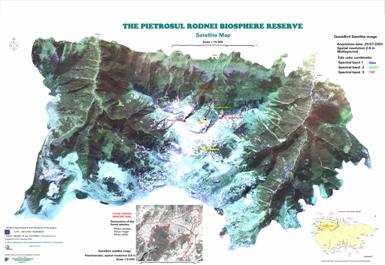
Digital distribution map of the Pietrosul Rodnei Biosphere Reserve
showing where the project site is places
? Scientific inventory of herbaceous species (A.1) ( pictures)
Across the Pietrosul Rodnei Biosphere Reserve, a comprehensive inventory of the herbaceous species was made and it was already included in the Project webpage. This inventory showed that the Biosphere Reserve is extremely rich in species, and the following botanical characteristics are highlighted here:
a number of 568 herbaceous species distributed within 58 families, were found;
the Asteraceae and Poaceae families with 98 and 54 species, respectively, were the richest ones, while a number of 13 families have only one species, each one;
most species were recorded on alpine and sub-alpine pasturelands but the herbaceous flora found under the forest canopy was, as normal, poorer mainly in conifers forests;
for Romania, there were found 22 endemic species, 18 rare species, seven protected species and nine protected and included in the Red List species ( Table 1 );
a number of seven threatened species at European level included in the IUCN List were found in the Pietrosul Rodnei Biosphere Reserve ( Table 1 );
Table 1: List of endemic, rare, protected and Threatened species from the
Pietrosul Rodnei Biosphere Reserve
Endemic species for Romania |
||||
1 |
Achillea schurii Schultz-Bip |
12 |
Oxytropis carpatica Uechtr. |
|
2 |
Aconitum moldavicum ssp. simonkaianum |
13 |
Phyteuma tetramerum Schur |
|
3 |
Alopecurus laguriformis (Schur) Tzvelev |
14 |
Phyteuma wagneri A. Kerner |
|
4 |
Campanula serrata (Kit.) Hendrych |
15 |
Poa deylii Khrtek et Jirasek |
|
5 |
Centaurea pinnatifida Schur |
16 |
Primula leucophylla Pax. |
|
6 |
Cerastium lerchenfeldianum Schur |
17 |
Pulmonaria rubra ssp. filarzskyana Jav. |
|
7 |
Dianthus tenuifolius Schur |
18 |
Salix retusa ssp. kitaibeliana Willd. |
|
8 |
Erysimum wittmannii Zawadzki |
19 |
Scabiosa lucida ssp. barbata Nyar. |
|
9 |
Festuca rupicola ssp. saxatilis (Schur) R |
20 |
Silene nivalis (Kit.) Rohrb. |
|
10 |
Heracleum carpaticum Porc. |
21 |
Soldanella hungarica ssp. hungarica Sim. |
|
11 |
Heracleum palmatum Baumg. |
22 |
Thlaspi dacicum Heuffel |
|
Rare species for Romania |
||||
1 |
Alopecurus laguriformis (Schur) Tzv. |
10 |
Oxytropis carpatica Uechtr. |
|
2 |
Botrichium multifidum ( Gmelin) Rupr. |
11 |
Salix bicolor Willd. |
|
3 |
Carex bicolor All. |
12 |
Saussurea alpina (L.) DC |
|
4 |
Draba carinthiaca Hoppe |
13 |
Saxifraga carpathica Reichenb. |
|
5 |
Erigeron nanus Schur |
14 |
Saxifraga hieraciifolia Waldst. et Kit. |
|
6 |
Festuca porcii Hackel |
15 |
Senecio carpaticus Herb. |
|
7 |
Juncus castaneus Sm. |
16 |
Silene nivalis (Kit.) Rohrb. |
|
8 |
Kobresia simpliciscula (Wahlenb.) Mack. |
17 |
Thlaspi dacicum Heuffel |
|
9 |
Lycopodium alpinum L. |
18 |
Tozzia alpina ssp. carpatica (Wol.) Hayek |
|
Protected species for Romania |
||||
1 |
Angelica archangelica L. |
5 |
Pinus mugo Turra |
|
2 |
Gentiana lutea L. |
6 |
Rhododendron myrtifolium Schott & Kots |
|
3 |
Leontopodium alpinum Cass. |
7 |
Trollius europaeus L. |
|
4 |
Pinus cembra L. |
|
|
|
Protected species for Romania (Red List) |
||||
1 |
Angelica archangelica L. |
6 |
Heracleum carpaticum Porc. |
|
2 |
Aquilegia nigricans Baumg. |
7 |
Leontopodium alpinum Cass. |
|
3 |
Arnica montana L. |
8 |
Rhododendron myrtifolium Sch. et Kots |
|
4 |
Erigeron nanus Schur |
9 |
Silene nivalis (Kit.) Rohrb. |
|
5 |
Gentiana lutea L. |
|
|
|
Threatened species at European level (IUCN List) |
||||
1 |
Achillea schurii Schultz-Bip |
5 |
Plantago atrata ssp. carpatica (Pilg.) Soó |
|
2 |
Arnica montana L. |
6 |
Silene nivalis (Kit.) Rohrb. |
|
3 |
Campanula serrata (Kit.) Hendrych |
7 |
Tozzia alpina ssp. carpatica Woloszc. Hayek |
|
4 |
Gentiana lutea L. |
|
|
|
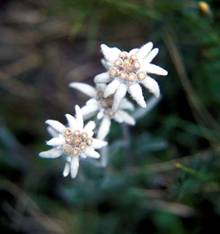
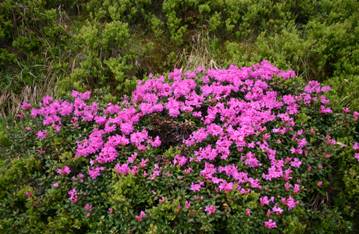
Leontopodium alpinum Rhododendron myrtifolium
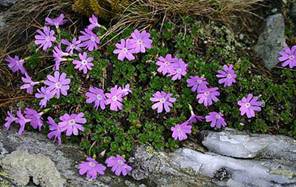

Primula minima Rhodiola rosae
? Scientific inventory of tree and shrub woody species (A.1) ( pictures)
Comparing with herbaceous species, as expected, the number of woody species was much smaller. There were found 57 species, of which 14 trees, 26 shrub and 17 sub-shrub species. The following aspects should be stressed:
P. cembra, P. mugo, P. abies, Sorbus aucuparia , and Alnus viridis are the most important woody species within the Pietrosul LIFE project area;
P. mugo is included in the Annex I Habitats Types, Code 4070 from Natura 2000;
Picea abies and Pinus cembra are components of habitat type according to the Habitats Directives, Code 9410 and 9420, respectively;
Pinus cembra and P. mugo are included in the Romania Protected Species List ( Table 1 ).
Concerning P. cembra , it should be stress that on the Pietrosul, a large population was growing in the past but now, the number of remained old trees is less than 40 and most of them are very old and highly dispersed or even isolated each other so that the inter-pollination is restricted while the self-pollination is the rule. Only three young trees naturally regenerated were found. This demonstrates that the heavy infusion, via LIFE project, with new planted P. cembra seedlings will prevent the extinction of the species population from Pietrosul.
It is significant to note that during our investigations on the subalpine zone, within the project area, just in the Zanoaga Mare Hollow a (perhaps) new two needle dwarf pine form or variety unlike P. mugo was found. This atypical form is now testing including through genetic means.
? Scientific draft concerning distribution and structure of the P. cembra / P.mugo / P. abies habitat in Pietrosul Rodnei Biosphere Reserve (A.1)
In order to get details about the distribution and structure of the woody species habitats, during the vegetation season of the 2005 year a comprehensive survey al over the Pietrosul Rodnei Biosphere Reserve was done. The survey focused on each of the three altitudinal levels of vegetation currently recognized, such as:
mountainous level with two sub-levels
average sub-level between 740 and 1100 m elevation;
high mountainous sub-level between 1100- 1500 m elevation;
sub-alpine level between 1500 and 1900 m elevation;
alpine level between 1900 and 2003 m elevation.
The mountainous level with its average sub-level between is characterized by the occurrence of the beech ( Fagus sylvatica ) and spruce ( Picea abies ) forests where Acer pseudoplatanus, Sorbus aucuparia and Betula pendula scattered trees can vegetate.
S ub-alpine level is characterized by the occurrence of the scattered or in groups, the following woody species: Pinus cembra, Juniperus sibirica and Rhodendron myrtifolium .
In its composition, the alpine level has small trees or bushes of Salix reticulate and Vaccinium gaultherioide.
It should be stressed that survey took into account not only woody vegetation but all environmental conditions in which it develops, such as: geology, geomorphology, hydrographic factors, soil,

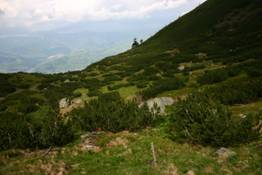
Picea abies, Pinus cembra and Pinus mugo associated species
? Scientific inventory of bird species (A.1) ( pictures)
A very detailed inventory of the birds was made by a specialist in ornithology from outside of our Institute. Because the Institute has no an ornithologist, this work was sub-contracted.
Over Pietrosul Rodnei Biosphere Reserve, a total of 86 bird species distributed at 58 genera, 28 families and nine orders were recorded ( Table 2 )
With its 18 families and 53 species, the Passeriformes order is the largest while the Cuculiformes order with only one family and one species, is the smallest one;
The Turdidae family with its 10 species is placed in the top of the rank;
Of 86 bird species, 87 % are nesting within the Biosphere Reserve while 13 % are passengers;
Again, of 86 bird species, 10 are present on the Romanian Red List, while only one ( Aquila clanga ) can be found on the European one ( Table 3 )
Table 2: Birds taxonomy
Orders |
Families |
Genera |
Species |
Anseriformes |
1 |
1 |
2 |
Falconiformess |
2 |
6 |
12 |
Galliformes |
2 |
3 |
4 |
Charadriiformes |
1 |
2 |
2 |
Columbiformes |
1 |
1 |
2 |
Cuculiformes |
1 |
1 |
1 |
Strigiformes |
1 |
4 |
5 |
Piciformes |
1 |
4 |
5 |
Passeriformes |
18 |
36 |
53 |
Total |
28 |
58 |
86 |
Table 3: The Red List of the birds from the Pietrosul Rodnei
Biosphere Reserve (PRBR)
Species |
PRBR |
Europe ** |
Species |
PRBR |
Europe |
Circaetus gallicus |
+ |
|
Tetrao tetrix |
+ |
|
Circus pygargus |
+ |
|
Scolopax rusticola |
+ |
|
* Aquila pomarina |
+ |
|
Glaucidum passerinum |
+ |
|
* Aquila clanga |
+ |
+** |
Aegalius funereus |
+ |
|
* Aquila chrysaetos |
+ |
|
Monticola saxatilis |
+ |
|
*According to the ORNIS Committee List (Annex II), the three Aquila species are priority for funding under LIFE. ** Aquila clanga is including in the European Red List
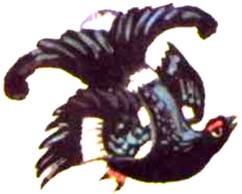

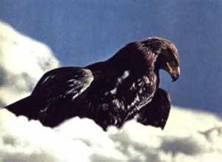
Tetrao tetrix Tetrao. urogalus Aquila chrysaetos
? Scientific inventory of mammal species (A.1) ( pictures)
The Mammals inventory has the following composition ( Table 4):
Forty one species distributed in six orders and 17 families;
According to the Romanian low 462 / 2001, six species require strict protection and they are included in the Red List, such as: Canis lupus, Lynx lynx, Neomys anomalus, Sicista betulina, Sorex alpinus and Ursus arctos ;
Of the European Red List, the following species are living in the Biosphere Reserve, as follows: Lynx lynx, Ursus arctos Canis lupus, Felis silvestris.
In the past until recently, the illegal hunting caused serious damages in wildlife. Also, the shepherds and local people and the tourists used to collect wild flowers and together with the domestic animal grazing they represented a destructive factor to the flora and fauna. It should be stressed that the factors contributing to the degradation of flora and fauna, mainly wildlife, significantly decreased in favor of restoration. This is because since early 2004, the Pietrosul Rodnei Biosphere Reserve was included within the Rodnei Mountains National Park which is administrated by the Romsilva National Forest State Administration . This National Park was provided with a staff, including 10 rangers. During the zear 2007, another two rangers will be hired. It is assumed that this guard team is able to take care of the whole Rodnei Mountains National Park area, including Pietrosul Rodnei Biosphere Reserve and the Pietrosul LIFE Nature restored habitats. Owing to this situation, the Project team has considered that it is not necessary to hire another parallel staff of rangers.
Table 4 shows that the Mammals Red List for the Pietrosul Rodnei Biosphere Reserve (which is valid for Rodnei Mountains National Park , as well) includes many in danger species, Ursus arctos and Canis lupus among them. Though, it is not present in this Red List, the black goat ( Rupicapra rupicapra )
from Pietrosul used to be considered in danger species because of the past illegal hunting. Due to the guard team of the Park, the situation was significantly improved.
Tab. 4: The Mammals Red List for the Pietrosul Rodnei Biosphere Reserve
|
Species |
Romanian Red List |
European Red List |
• |
Canis lupus |
+ |
+ |
• |
Felis silvestris |
+ |
|
• |
Lynx lynx |
+ |
+ |
• |
Muscardinus avellanarius |
|
+ |
• |
Myotis blythi |
+ |
|
• |
Neomys anomalus |
+ |
|
• |
Rhinolophus ferrumequinum |
+ |
+ |
• |
Rhinolophus hipposideros |
+ |
+ |
• |
Sciurus vulgaris |
|
+ |
• |
Sicista betulina |
+ |
+ |
• |
Sorex alpinus |
+ |
|
• |
Ursus arctos* |
+ |
+ |
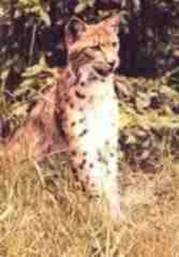
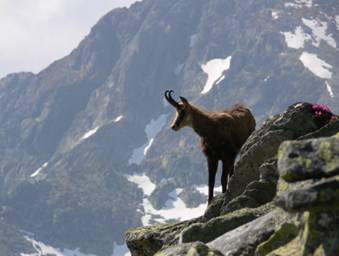
Lynx lynx Rupicapra rupicapra
NOTE:
The inventories of the following three categories of fauna were not foreseen as project tasks but the inventories were made
? Fishes inventory
Table 5: Fishes inventory
|
Species |
|
Species |
1 |
Cottus gobio L. |
4 |
Salmo trutta fario L. |
2 |
Cottus poecilopus Heck. |
5 |
Thymallus thymallus |
3 |
Phoxinus phoxinus L. |
|
|
? Amphibians inventory
Table 6: Amphibians inventory
Species |
Species |
Bombina variegata |
Salamandra salamandra |
Bufo viridis |
Triturus alpestris |
Rana dalmatiana |
Triturus montandoni |
Rana temporaria |
|
? Reptiles inventory
Tab. 7: Reptiles inventory
|
|
Anguis fragilis |
Natrix natrix |
Lacerta abilis |
Vipera berus |
Lacerta vivipara |
|
? Purchasing durable goods from Action A.1
The following durable goods were purchased: GIS soft upgrading; hardware upgrading; digital camera; Quick Bird satellite imagery. These durable goods have been currently used for implementation of the project specific actions.
It is recognized that without the above mentioned equipment, some project actions could not be solved.
? A ction A.2
¦ Foreseen tasks with Action A.2:
? P reparation of the technical management plan aiming at P. cembra species re-introduction and P. cembra / P.mugo / P. abies habitat restoration (A.2)
¦ Achieved results with Action A.2:
? T echnical plan aiming at habitat restoration
A technical management plan was conceived, comprising step by step all activities aiming at P. cembra species re-introduction and P. cembra / P.mugo / P. abies habitat restoration on 50 ha . This plan was made and already applied as a guide during the last three years in order to ensure the success of Pinus cembra and Picea abies re-introduction by planting as specified with the Action C.1. This project comprises all actives connected with the objective to be reached, such as: techniques for planting stock production, including seed origin, seed collection and processing, nursery techniques, planting technique, etc and all concerned costs.
? Action A.3
¦ Foreseen tasks with Action A.3:
? Long-term Conservation Management Plan to enforce sustainable activities of all flora and fauna habitats from Pietrosul Rodnei Biosphere Reserve
¦ Achieved results with Action A3:
? Preparation Management Plan for the Pietrosul Rodnei National Park including Pietrosul Rodnei Biosphere Reserve
The Pietrosul Rodnei National Park did not exist in the year 2002 when the LIFE-Nature Application Forms were prepared. As state institution, it was created in the 2004 year when the Pietrosul Rodnei Biosphere Reserve was included within it. For this reason the elaboration of Management Plan was foreseen for the Pietrosul Rodnei Biosphere Reserve including the Pietrosul new habitat created through the LIFE-Nature Project.
Taking into account the inclusion of the Biosphere Reserve and project area inside of National Park, the present management plan was extended to the whole National Park with specific references to the LIFE Pietrosul project area.
The management plan includes actions to be taken during life project and established working framework for long-term conservation and management for the whole National Park. Furthermore, the plan integrates the economic and conservation activities in a holistic concept for sustainable development of the area in question with special emphasis to specific actions regarding woody habitats restoration and conservation of all flora and fauna habitats. Previously, through the three workshops (preparatory, intermediary and final) there took place a consultation process with local administrations, stakeholders and some local people, in order to create a working framework for local people. Members of Commission of the Nature Monuments , staff and Scientific Council of the National Park and Life project team attended in the management plan preparation.
It should be stress that alongside the foreseen management action concerning the National Park, specific protection and conservation measures for project plantation were inserted in the management plan. Based on this plan, the Life project actions will be continuing, so that, long-term conservation of all flora and fauna habitats, including P. cembra / P. mugo /P. abies one will be achieved.
? Action A.4
¦ Foreseen tasks with Action A.4:
? Set up the Advisory Board and Management Project Team
¦ Achieved results with Action A.4:
? Workable Advisory Board and Project Team
To ensure the correct implementation of the project, on January 2004, the A dvisory Board and Management Project Team were set up.
The Advisory Board consists of 17 members and includes representatives of the local authorities of the economic and cultural institutions, land owners, forest administrators, fisher men and hunters and the Forest Research Institute representatives, as well. The main task of this Advisory Board is to ensure the project implementation, acting as a working framework. The board has had two meetings yearly where the project manager, presented the achieved results followed by discussions..
The Management Project Team consists of 14 members and it is composed of scientists whom background is connected with the scope of the project. The status of the project implementation was reported to the Advisory Board.
? Action C.1
¦ Foreseen tasks with Action C.1
? Effective re-introduction of P. cembra and restoration of P. cembra / P.mugo / P. abies habitat by planting in the Zanoaga hollow from the Pietrosul Rodnei Biosphere Reserve
¦ Achieved results with Action C.1:
? Sticks preparation
A number of 12 350 conifer wood sticks were prepared to be used for land picketing. The stick dimensions were 100 cm long, 5 cm wide and 3 cm thick.
? Land marking / picketing
This was the first field operation aiming at marking the place where the seedling bed has to be hoed . To be visible from distance, in the years 2004, 2005 and 2006 each of the 12350 seedling beds covering 50 ha were marked by prepared sticks. The sticks helped the worker to locate the place where the seedling bed has to be prepared.




On the back sticks transport, picketing (upper pictures) and the
Picked area (Piciorul Mosului) where avalanches occurred
? Seedling bed or site preparation
The operation of hoeing of the seedling bed took place, immediately after the land picketing, i. e. mid June of the years 2004, 2005 and 2006. The seedling bed dimensions were of 80 cm x 80 cm a 20 cm depth. Because of the extremely harsh environment conditions (compact and/or lack of soil, dense Vaccinium sp. and herbaceous layer, stony ground, presence of bushes, etc.), this operation was made by the mountain special hoe. According to the site conditions, two kinds of tools were used, such as: the hoe when the soil was rock less and crowbar when the seedling bed substratum consisted more of stones than soil. By this way, a total of 12350 seedling beds were prepared
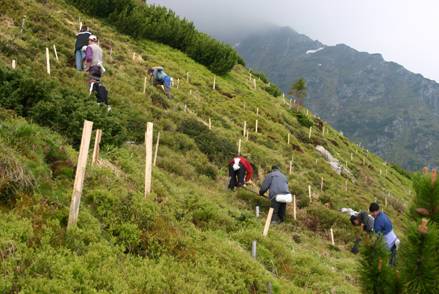
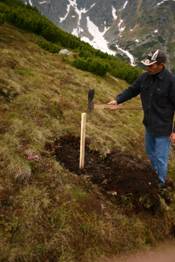
Seedling beds preparation
? Seedling origin and their production
The P. cembra reintroduction and restoration of P. cembra / P.mugo / P. abies habitats was conceived to be made according to the genetic and ecological requirements. For this reason, P. cembra seedlings originate in the natural population Lala Valey near the Inau Mountain , a massive included, as Pietrosul, in the same Rodnei Mountains range. Therefore, the Lala Valey population has the same genetic structure and ecological requirements as that from Pietrosul Mt. where the project area is placed. Prior to launch the Project, these seedlings were already produced in the Sinaia Nursery belonging to the Bucharest Forest Research and Management Institute. The seedlings were grown in individual plastic bags fill in with acidophilus spruce humus. At the planting moment some of seedlings were seven to nine years old and they were very ell developed and health (See the nursery picture). Each seedling including potted soil has weighted between 4- 6 kg . Using potted seedlings ensures the planting success.
Picea abies and Pinus mugo seedlings have their origin in the Pietrosul Mountain natural population, i. e. very close to the project area.
To anticipate an answer to the question why not the Pietrosul P. cembra provenance was used for its population restoration, the following answer is given: just because, as earlier stated, the Pietrosul natural population is very close to extinction and the resulted seed / seedlings are from self / pollination and such seedlings / tree have very low survivals.
All the seedlings were produced by the ICAS as beneficiary / partner at its Sinaia Nursery located at about 700 m elevation. As mentioned in the Application Forms, the cost of the seedlings represents almost the entire Beneficiary's co-financing.

. 
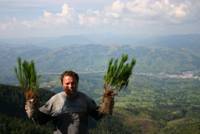
The Valea Larga Nursery from Sinaia (ICAS owner)
Pinus cembra (upper picture) and Pinus mugo seedlings (green darker color seedlings from lower pictures) at age seven prior departure to Pietrosul for plantation (Original I. Blada)
? S eedlings transport
The seedling transportation took place from Sinaia Nursery to Borsa and then up to Pietrosul Mt. proved to be a very difficult task because:
the seedlings were grown in plastic pots fill in with soil and for this reason, they could not be overlap during transportation;
the Sinaia Nursery is placed in a hollow and because of this, the seedling transportation to the accessible road for trailer had to be made by a cart pulled by a horse from 600 to 750 m elevation;
then the seedlings were loaded in big trailers and transported about 650 km to the Borsa down town;
then the seedlings were transferred on four powerful lorries and transported seven km to the Borsa outskirts placed at 700 m elevation where the seedlings were unloaded;
then the seedlings were transported to the mountain planting site at about 1700 / 1800 m elevation; only a caterpillar tractor could make this transport on a very bad and sloppy primitive road, (See photo); only 300 seedlings could be taken on each drive / transport and two drives a day; 20 transport / days; a number of 20 days were necessary for 12 350 seedlings transportation from Borsa outskirts intermediate deposit to the Pietrosul Mt.
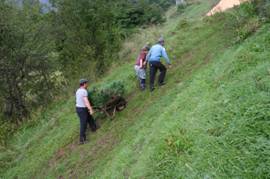
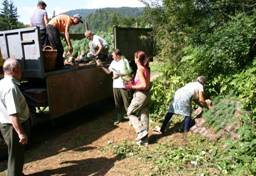
From Sinaia Nursery to the access road From Sinaia Nursery access road to Borsa outskirts
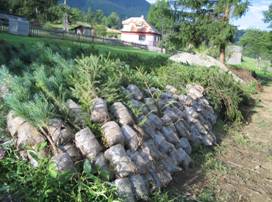

Intermediate deposit at Borsa outskirts From Borsa outskirts to Pietrosul at 1700 m a.s.l.
? Seedlings distribution to the seedling beds
By using wood baskets, the 12350 potted seedlings were carried by the workers (on their back) to the planting beds distributed all over 50 hectares . Because of the basket weight (about 30 kg ) and sloppy land and wild vegetation, this work was very hard and difficult. For transportation 12350 potted seedlings, about 400 up and down runs took place.
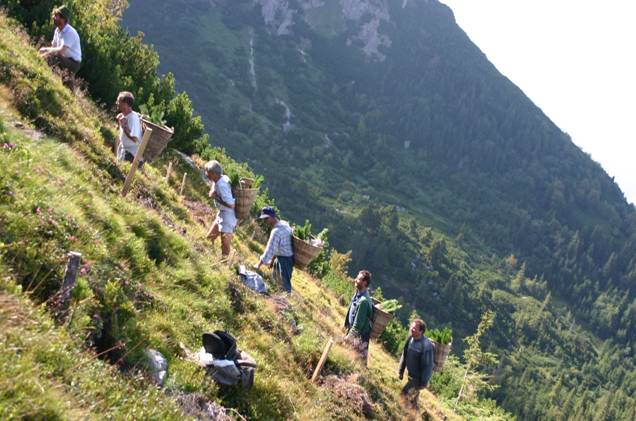
On the back by baskets transportation seedlings to the seedling beds
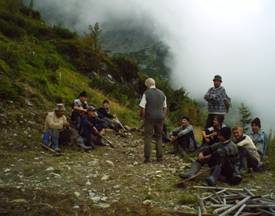
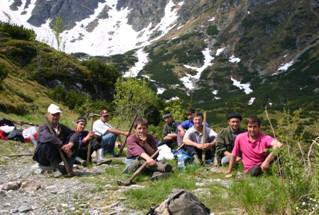
The working team rests after a hard working day
? B orrowed soil transport
On some parts of the planting area, about 1000 seed bed required borrowed soil. This soil was transported by the caterpillar tractor from 800 m elevation outside Biosphere Reserve, to about 1700 m elevation where it was deposited. From that place, using wood baskets, the workers carried the soil on their back to the soil less seedling beds. It was a hard work.
? Pl anting site, p l anting design and plantation
The planted area is laying out on the northern slope of Pietrosul Mt. between 1600- 1990 m elevations, namely across the Zanoaga Mare and Piciorul Mosului .
The initial foreseen planting design . Because an ecological plantation was assumed to be made, the tree too tree distance varied between 2 to 20 m , i. e. a 10 x 10 m average distance was taken into account. The intention was to restore the past local landscape, if possible. For this reason, an irregular planting framework was adopted. It is well known that P. cembra and P. abies trees are "tall" species while the P. mugo is a dwarf bush trees. Therefore, the 5000 P. mugo seedlings were planted (over the same 50 hectares ), at irregular distance, among the other two tree species. In other words, it was not taken into account at the area calculation. This infusion with P. mugo will speed up restoration of the above ground carpet which soon contributes to the soil protection.
The real applied planting design : Taking into account the newly acquired information about the planting area, the initial plan was slightly improved. It was learned that after previous trees cutting, the Piciorul Mosului steep slope became a place with avalanche occurrence. Two avalanches occurred on winters of 2005 and 2006 when five people were killed. Consequently, in order to prevent the avalanche initiation it was decided to increase the plantation density by planting 5 550 seedlings (2 350 P. cembra and 3 200 Sorbus aucuparia local provenance) in addition, so that on the same 50 hectares , altogether, 15550 instead 10 000 seedlings were planted. Sorbus aucuparia is naturally spread all over the Pietrosul sub-alpine ecosystem where at its early age it growth faster than any other local species and in addition resistant to harsh climatic conditions. It is expected that at least for the long term, this mixed population will play a positive role in avalanche control. It should be stressed that in the first version of the Application forms of this LIFE project, S. aucuparia was proposed to be included in the P. cembra / P. mugo / P. abies habitat but the proposal was rejected during the Application revision at European Commission level. This species can not be missed from Pietrosul sub-alpine habitats / ecosystem.
The plantation was made in late August of the 2004, 2005 and 2006 years, consecutively. Plantation hole was of 30 x 30 cm deep and placed in the center of the seedling bed. Each seedling of P. cembra and P. abies was planted separately in its whole while P. mugo and S. aucuparia one seedling of which were planted in the same whole. At early age and in sub alpine zone, the S. aucuparia growth much faster than any other woody tree species, so that the taller and denser the trees the most efficient against avalanche initiation. That is the reason why the
S. aucuparia was planted on the avalanche track. It should note that all 10000 seedlings foreseen initially were grown in plastic bags and planted bag less; this working procedure ensure a high level of surviving or success. The other 5550 seedlings were planted with bare roots some losses are expected. The in addition 5500 planted seedlings, including the man-power, were not included in the project expenses.


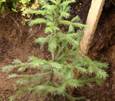
P. cembra P. mugo P. abies
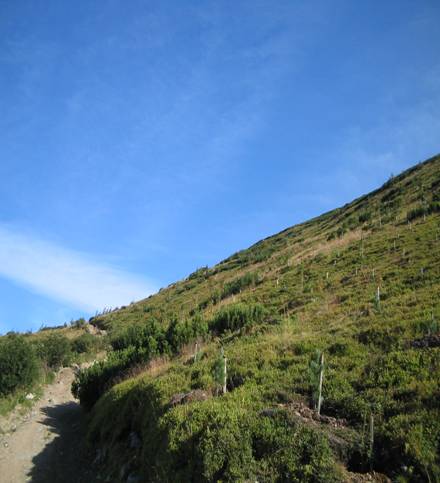
A sam of planted area
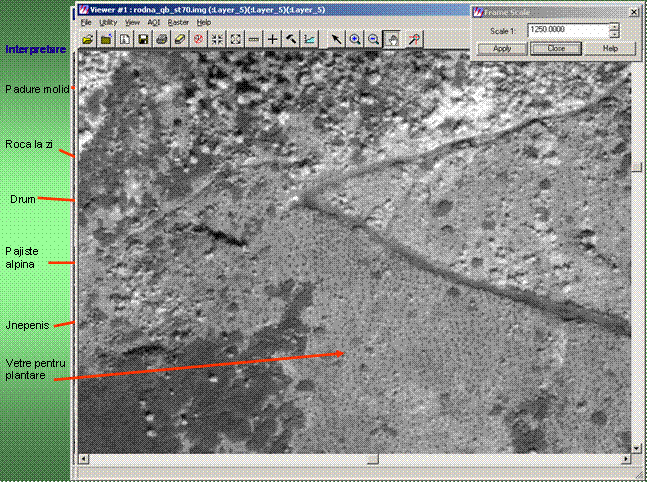
Quik Bird Satellite Imagery taken on July 10, 2004 : the seedling beds of 80 x 80 cm size can be seen from satellite
? Action C.2
¦ Foreseen tasks with Action C.2
? Construction of refugee chalet and a toilet
¦ Achieved results with Action C.1:
? C halet and toilet constructed
In order to sheltering scientists and technicians and workers during the project implementation and rangers during Management Plan implementation, a refugee chalet was built alongside the LIFE-Nature project area.. Initially, a one room chalet was planned but finally a two room chalet including an attic was built. The conifer wood was used as basic material for construction of all components such as: infrastructure, walls, roof of shingle, doors and windows. For the indoor against cool protection a Rigip isolation layer was placed on the inside face of the walls. For a better outdoor protection against moisture, the external walls of the refugee chalet were painted using a yellowish oil paint. For the same reason, the roof was painted with a two layers mineral oil of dark color. The inside refugee chalet was equipped with superposed beds and other strict necessary equipment. Altogether, 16 persons can be accommodated in the two rooms and the attic. At about 150 m away from chalet, a primitive toilet was built. It should be stressed that the amount of currency foreseen in the Application Forms for this action was by far sub-evaluated and for this reason, the Forest Administration of the Maramures County and the Borsa Forest District) contributed free of charge with woody materials and other things.
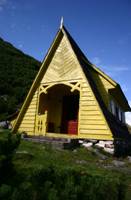


Implementation of the Action C.1 could not take place without this chalet
? Action C.3
¦ Foreseen tasks with Action C.3
? Information panels, construction and their installation
¦ Achieved results with Action C.3:
? Panels construction and installation
Ten information panels, five in Romanian and five in English, were made on plastic material. The panel text (See the enclosed photos), written electronically using the Corel Program, comprises the European Community recommendations, such as:
the LIFE logo and partners logos placed in front of the panel;
the project objectives;
the project major actions;
a specific recommendation to the public to protect the planted trees and all flora and fauna species from the whole Biosphere Reserve.
the satellite map of the Pietrosul Rodnei Biosphere Reserve was placed on the panel lower side.
The panels were installed in strategic places accessible and visible to the public
With regard to the way the panels were installed, it should be stressed that a Romanian together with an English version of the panel were placed on the same 1 m tall x 1 m wide board, i. e. one version was inserted on the back of the other. In its upper side, each panel was equipped with a roof while in the lower side with two feets
Because the allocated amount for this Action was not entierly spent, some other panels could be order in the 2005 year.
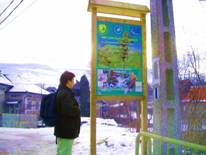

The first panel was installed at the entrance in Borsa while the second one inside
near the tourist road that climbs to the Pietrosul Pick
? Action D.1
¦ Foreseen tasks with Action D.1
? Implementation of Long-term Conservation Management Plan by integrating the best measures for conservation of all flora and fauna habitats from the Pietrosul Rodnei Biosphere Reserve
¦ Achieved results with Action D.1 :
? Implementation of Management Plan already started
This process had to start on April 2006 but because the Management Plan was finished on December the same year, it starts fully now on early January 2007. However, prior conceiving the Management Plan, the process of public awareness was launched since 2004 year. Installing the 10 information panels containing specific inscriptions regarding objectives and importance of the LIFE-Nature project for the Pietrosul Rodnei Biosphere Reserve was considered as first important action of public awareness. Then, in the framework of the public awareness, information concerning the project actions and results, were presented in Power Point in the following institutions: Agricultural Institute of Cluj, May 13 2005; Forest Research Station of Cluj, May 13, 2005; Faculty of Silviculture of the Brasov University, May 23, 2005; Forest Research Station of Brasov, May 23, 2005; Faculty of Biology of Bucharest, September 23, 2005; Forest Research and Management Institute of Bucharest, October 18, 2005; Nasaud High School, November 22, 2005.
Since the last two years, the staff of the Rodnei Mountains National Park has written a Ranger Instruction-Guide for the five rangers guard team. This guide foresee details about how the ranger has to act in all possible circumstances in order to prevent any damages to the flora and fauna habitats from the whole Rodnei Mountains National Park which includes the Pietrosul Rodnei Biosphere Reserve and the Pietrosul LIFE area, as well. The staff of the Park, together with the LIFE project team, based on the written Guide, has made a theoretical instruction to the guard team. The access of the tourists and local people to the project area was reduced.
Other restrictive actions were established, as follows:
reducing access of the tourists and local people to the important birds nesting areas and to those areas with a higher frequency of carnivores, mainly Ursus arctos, Canis lupus and Marmota marmota ;
the access of the armed people inside National Park was totally and permanently prohibited;
a strong control of the hunters and stray dogs;
the project area of 50 hectares was established as special protected area.
An agreement with the mountain police service was established and their help in conflict extinction has been essential.
At present, the Management Plan is ready and starting with early January 2007, the integrated measures concerning protection and conservation of the flora and fauna habitats from the Rodnei Mountains National Park (including the Pietrosul Rodnei Biosphere Reserve and the Pietrosul LIFE area, as well), have been implementing in full, as defined in the Plan objectives. Owing to the above mentioned measures, flora and fauna habitats / species will have better conditions for conservation and development than in the past.
? Action D.2
¦ Foreseen tasks with Action D.2
? Monitoring of evolution process of P. cembra species re-introduction and P. cembra / P. mugo / P. abies habitat restoration to the end of the project
¦ Achieved results with Action D.2 :
? Preliminary observations
This action was planned to be solved next year. However, since 2005 year, 10 (instead of three as foreseen) permanent sample-plots were marked across the project area. Each plot with a circle form with 13 m radius was marked at its centre with a red stick to be seen from distance. Within each circular sample an inventory of the seedlings was made in the autumns of 2005 and 2006 years. The plantation average success (%) per species was very high, such as: 97 % in P. cembra and 95 % in P. mugo and P. abies . The next monitoring will be done on early June 2007, after snow melting when some other traits will be recorded, such as: growth and behavior or resistance to harsh climate. Then a final draft before project termination will be compiled.
It must be stress that, in August 2007, the died seedlings will be replaced; the expenses will be supported by ICAS.


? Action E.1
¦ Foreseen tasks with Action E.1
? Set up the project website
¦ Achieved results with Action E.1 :
? Workable website
On behalf of the LIFE Project, on January 2005, a website was opened at the following address:
http://www.icassv.ro/life_pietrosu
? Action E.2
¦ Foreseen tasks with Action E.2
? Design, print and disseminate informative materials
¦ Achieved results with Action E.2
? Printed brochure and two leaflet
There were designated and printed a brochure and a leaflet containing scientific information about re-introduced P. cembra species and restored P. cembra / P. mugo / P. abies habitat. It was demonstrated the way through which this re-introduction and restoration was achieved. The brochure and leaflet contain integrated measures and results with regard to protection and conservation habitats not only woody but herbaceous, bird and carnivore species from the Rodnei Mountains National Park including Pietrosul and LIFE project area. By using the ICAS printing equipment and materials, 4 000 brochures and 2000 leaflets (in Romanian: PLIANTUL NR. 1 and PLIANTUL NR. 2, 1000 for each) were printed and partially were already disseminated inside the country. These materials, will be distributed free of charge in schools from Maramures County , including Borsa town and in key points for tourists. The rangers have also the task to distribute them. The main universities, forest districts from mountainous regions, non governmental organizations, and people involved in nature protection will be another beneficiary category of these printed materials.
The materials will help at gaining acceptance and collaboration from local communities, as a basis for implementation of the information exchange with different bodies, such as national authorities, stakeholders, LIFE project beneficiaries, etc.
? Action E.3
¦ Foreseen tasks with Action E.3
? Local workshops and stakeholder consultation meetings
¦ Achieved results with Action E.3
? Workshops and stakeholder consultation meetings
First local workshops and stakeholder consultation meeting was held o n October 1, 2004 , at the Borsa Town , with the following schedule:
Presentation of the Project solved actions during the 2004 year (I. Blada and A. Filip);
Presentation of the Rodnei Mountains National Park : images and figures (D. Jauca and A. Hadarau).
Stakeholder consultation meeting.
Visiting the 50 hectares planted area with P. cembra and P. abies in the Zanoaga Hollow and Piciorul Mosului from the Pietrosul Rodnei Mountain.
The workshop was attended by 37 persons belonging to: local authorities, local and regional forest administrations, representatives of local economy, and representatives of the Commission of the Nature Monuments, the LIFE epresentatives, fishermen and hunters.
The first two items were presented on Power Point followed by discussions and questions. Plantation of 50 ha , placed on difficult geographic conditions, was very much appreciated.
After presentation of the first two items, stakeholder consultation meeting took place. Discussions were focused on current problems that are facing not only the project but also the whole National Park. It was welcomed the European Community financial support to the project.
After indoor meeting, in a very sunny afternoon, the younger participants climbed the mountain and visited the planted area where the encountered problems were presented.

? Second local workshops and stakeholder consultation meeting
The project second workshop and stakeholder consultation meeting took place in the Borsa Town Hall , on October 13, 2005 ,. A total of 38 people, including local and regional authorities, and scientists attended the workshop.
The workshop programme presented in Power Point was:
Scientific inventory of the herbaceous and woody species from the Pietrosul Rodnei Biosphere Reserve (Dr. Gh. Coldea).
Scientific inventory of the bird species from the Pietrosul Rodnei Biosphere Reserve (Dr. Iosif Beres).
Restoration Pinus cembra / P. mugo / Picea abies habitats: plantations with Pinus mugo (Dr. I. Blada, I. Muntean, S. Tanasie, A. Dragila and C. Dinu).
A high interest of the participants in supporting the project actions was the main conclusion of that workshop.
The stakeholder consultation meeting took place as the last indoor item where both the officials and scientists discussed and analyzed the present status of the Project. Discussions from the meeting were focused on current problems that are facing not only the project but also the whole Rodnei Mountains National Park . The financial support of the European Community was very much appreciated recognizing its contribution to the restoration of the habitats from the Pietrosul Rodnei Mountain . It was appreciated that the habitats restoration by planting according to the Project objectives is going on very well as 67 % of the of the objective was accomplished after two working seasons, only.
After the indoor meeting, the youngest participants have climbed the Pietrosul Mountain and visited the 2005 and 2004 plantations from the Project area. It was recognized that the plantations with the three species look very well even though a lot of difficulties were encountered during the seedlings transportation and plantation at high elevation.
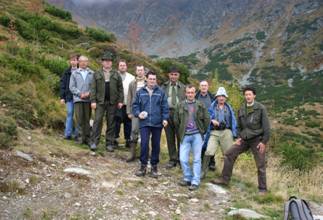
Only 12 young participants have climbed
the Pietrosul Mountain to see the planted area
? Public awareness
In the framework of the public awareness, information concerning the project actions and results, were presented in Power Point in the following institutions:
Agricultural Institute of Cluj , May 13 2005 ;
Forest Research Station of Cluj, May 13, 2005 ;
Faculty of Silviculture of the Brasov University , May 23, 2005;
Forest Research Station of Brasov , May 23, 2005 ;
Faculty of Biology of Bucharest , September 23, 2005 ;
Forest Research and Management Institute of Bucharest , October 18, 2005 ; Nasaud High School , November 22, 2005 .

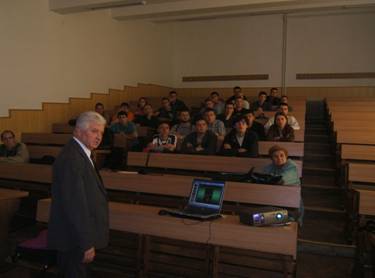
Between September 19-23, 2007, the LIFE project manager has organized Valiug, Romania, an international IUFRO Conference in five needle pines, including Pinus cembra where 37 scientists from 11 countries attended. A Power Point presentation about the Pietrosul LIFE-Nature project and the first film were presented during this Conference. As specialists in pines, the attendees highlighted the importance of Pinus cembra reintroduction and Restoration of Pinus cembra / P. mugo / Picea abies habitats from Pietrosul

Some participants to the IUFRO Conference
? Action E.4
¦ Foreseen tasks with Action E.4
? Video documentaries and media presentations
¦ Achieved results with Action E.4
? Video documentary films
First video documentary film ( Title: Refacerea habitatelor or Habitats restoration )
Images for the first film were collected during the year 2005 and film was finished on early January 2005. The intention was to show how the plantation and its associated actions are going on in difficult mountainous conditions. Seeing the film sequences, one can see how danger was the seedling transport, on a primitive bad road, from Borsa to Pietrosul at about 1700 m elevation. Heavy action connecting with caring sticks and seedlings on the worker back over the very sloppy planting area, digging or hoeing seedling beds and plantation in a stony and sloppy land were also caught in the film. The film duration is about 25 minutes.
According to the Standard Provisions recommendation, the LIFE logo the recognition Community financial contribution was clearly inserted in the film.
Second video documentary film (( Title: Date despre vegetatia din Pietrosul or Data about vegetation from Pietrosul Rodnei) )
This film presents details about flora from the Pietrosul and its surroundings. Images were collected during the vegetation season of the year 2006 and the film was ready just before the end of the year. The duration of the film is about 50 minutes
The two documentary films will be displayed in already planned public awareness regarding the LIFE project actions and its acquired results, in the third project workshop, and on TV. The film will be presented in national and international meetings on nature habitats restoration and conservation.
In order to disseminate the LIFE project results, DVD copies of the films will be distributed to different organizations involved in nature protection, universities and some high schools.
The address where the two film masters are deposited at the following film Company:
Company: Albu Mihai Liviu Asociatie Familiara
Adress: Str. Stavilarului No. 6, Borsa, Judetul Maramures , Romania
E-mail: studio_aml@yahoo.com
? Durable goods procurement in Action E.4
In the framework of the project, a Sony video camera was purchased. It proved to very useful to collect images for films and other aspects connected to the project area.
? Action F.1
¦ Foreseen tasks with Action F.1
? Project management and monitoring
¦ Achieved results with Action F.1
? Reports
Two annual technical and financial progress reports (2004, 2005), one technical and financial interim report (2006) and an audit interim independent report (2006) were prepared and send to the European Commission and external monitoring team.
? Action F.2
¦ Foreseen tasks with Action F.2
? Workstation Development
¦ Achieved results with Action F.2
? Purchased equipment
? In the frame of this action, the following durable goods were purchased: two desktop PC, a laptop, and a printer. The laptop was purchased instead of a desktop. This laptop helps the working team in order to be used when outside the Institute. The three computers proved to be very useful for office everyday activities and project database establishment. The flipchart and slide and overheads projectors were not purchased as they are of no too much use as the presentations can be easier done on power point which was already used during the first workshop.
Summary of deliverable products fulfilled
between January 1, 2004 and December 31, 2006
(Blue: solved actions); (Red: unsolved actions)
Product |
Action |
Deadline |
GIS distribution map of the flora and rocky ecosystems / habitats, including P. cembra / P.mugo / P. abies ones, from Pietrosul Rodnei Biosphere Reserve ( 6415 ha ) |
A.1 |
February 2004 |
Scientific inventory of tree and shrub woody species / habitats from Pietrosul Rodnei Biosphere Reserve ( 6 415 ha ); |
A.1 |
July 2004 |
Scientific draft concerning distribution and structure of the P. cembra / P.mugo / P. abies habitat in Pietrosul Rodnei Biosphere Reserve ( 6 415 ha ); |
A.1 |
December 2004 |
Scientific inventory of herbaceous species / habitats from Pietrosul Rodnei Biosphere Reserve ( 6 415 ha ); |
A.1 |
October 2005 |
Scientific inventory of bird and mammals habitats from Pietrosul Rodnei Biosphere Reserve ( 6 415 ha ); |
A.1 |
October 2006 |
Technical management plan comprising step by step all activities aiming at P. cembra species re-introduction and P. cembra / P.mugo / P. abies habitat restoration on 50 ha |
A.2 |
December 2003 |
Long-term Conservation Management Plan to enforce sustainable activities of all flora and fauna habitats on 6 415 ha from Pietrosul Rodnei Biosphere Reserve |
A.3 |
January 2004 |
Refugee chalet and toilet cabin |
C.2 |
Sept. 2003 |
A draft showing the evolutionary process of P. cembra species re-introduction and of P. cembra / P. mugo / P. abies habitat restoration on 50 ha at the end of the project |
D.2 |
May 2007 |
Project Website |
E.1 |
October 2004 |
4 000 printed brochures and 2 000 leaflets |
E.2 |
April 2006 |
Layman's report |
E.2 |
July 2006 |
First video documentary film |
E.4 |
July 2005 |
Second video documentary film |
E.4 |
June 2006 |
First Technical Progress Report |
F.1 |
December 2004 |
Second Technical Interim Report |
F.1 |
December 2005 |
Third Technical Progress Report |
F.1 |
December 2006 |
Final Technical Report and independent audit report |
F.1 |
June 2007 |
Activity reports foreseen
(Progress Interim Report)
First Progress Report |
December 2004 |
Technical Interim Report |
December 2005 |
Third Progress Report |
December 2006 |
Final Report |
June 2007 |
Summary of project milestones fulfilled between 2004-2006
(Blue: solved actions); (Red: unsolved actions)
Milestone |
Action |
Deadline |
Set up the Advisory Board and Management Project Team . |
A.4 |
Sept. 2003 |
Effective re-introduction by planting P. cembra species and restoration of P. cembra / P.mugo / P. abies habitat on 20 ha (remainder 30 ha ) in the Zanoaga hollow from the Pietrosul Rodnei Biosphere Reserve (Part one). |
C.1
|
October 2004 |
Effective re-introduction by planting P. cembra species and restoration of P. cembra / P.mugo / P. abies habitat on 20 ha (remainder 10 ha ) in the Zanoaga hollow from the Pietrosul Rodnei Biosphere Reserve (Part two) |
C.1
|
October 2005 |
Effective re-introduction by planting P. cembra species and restoration of P. cembra / P.mugo / P. abies habitat on 10 ha (to get 50 ha as planned) in the Zanoaga hollow from the Pietrosul Rodnei Biosphere Reserve (Part three) |
C.1
|
October 2006 |
10 information panels planted in key places |
C.3 |
July 2004 |
Implementation of Long-term Conservation Management Plan by integrating the best measures for conservation of all flora and fauna habitats on 6 415 ha from the Pietrosul Rodnei Biosphere Reserve |
D.1 |
April 2006 |
First Local Workshop followed by an excursion to the project area.
|
E.3 |
June 2004 |
Second Local Workshop followed by an excursion to the project area.
|
E.3 |
June 2005 |
Third Local Workshop followed by an excursion to the project area. |
E.3 |
May 2007 |
Workstation Development |
F.2 |
December 2003 |